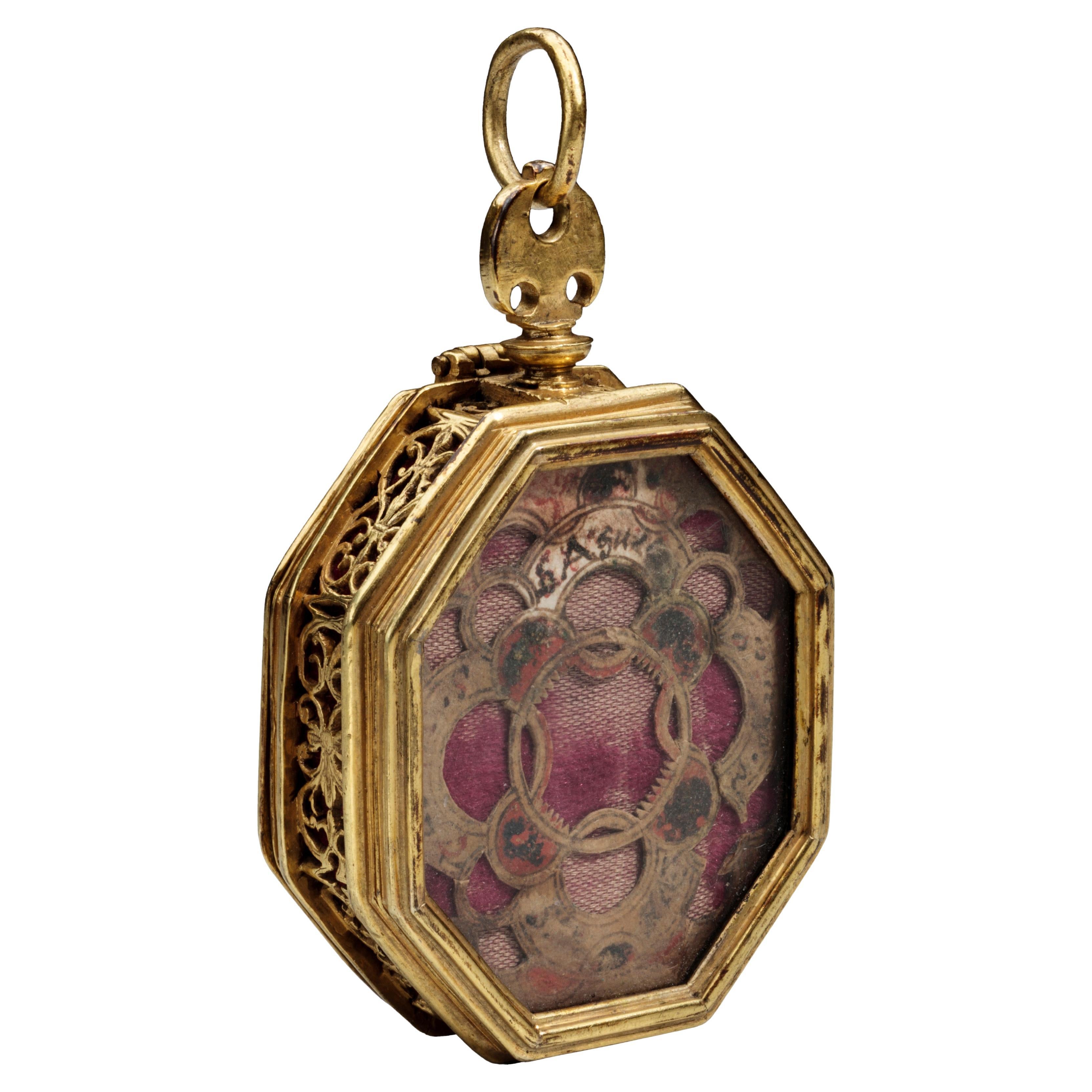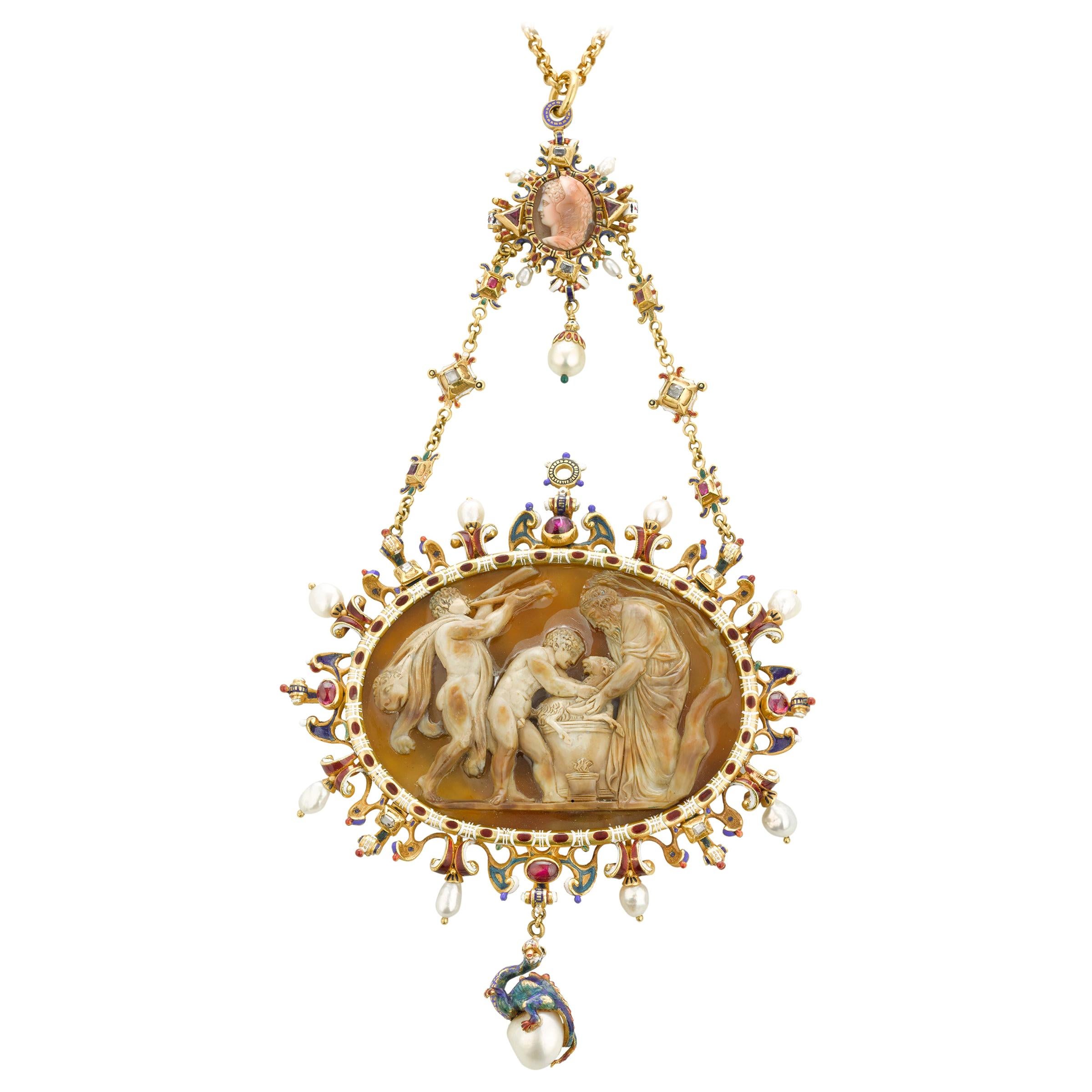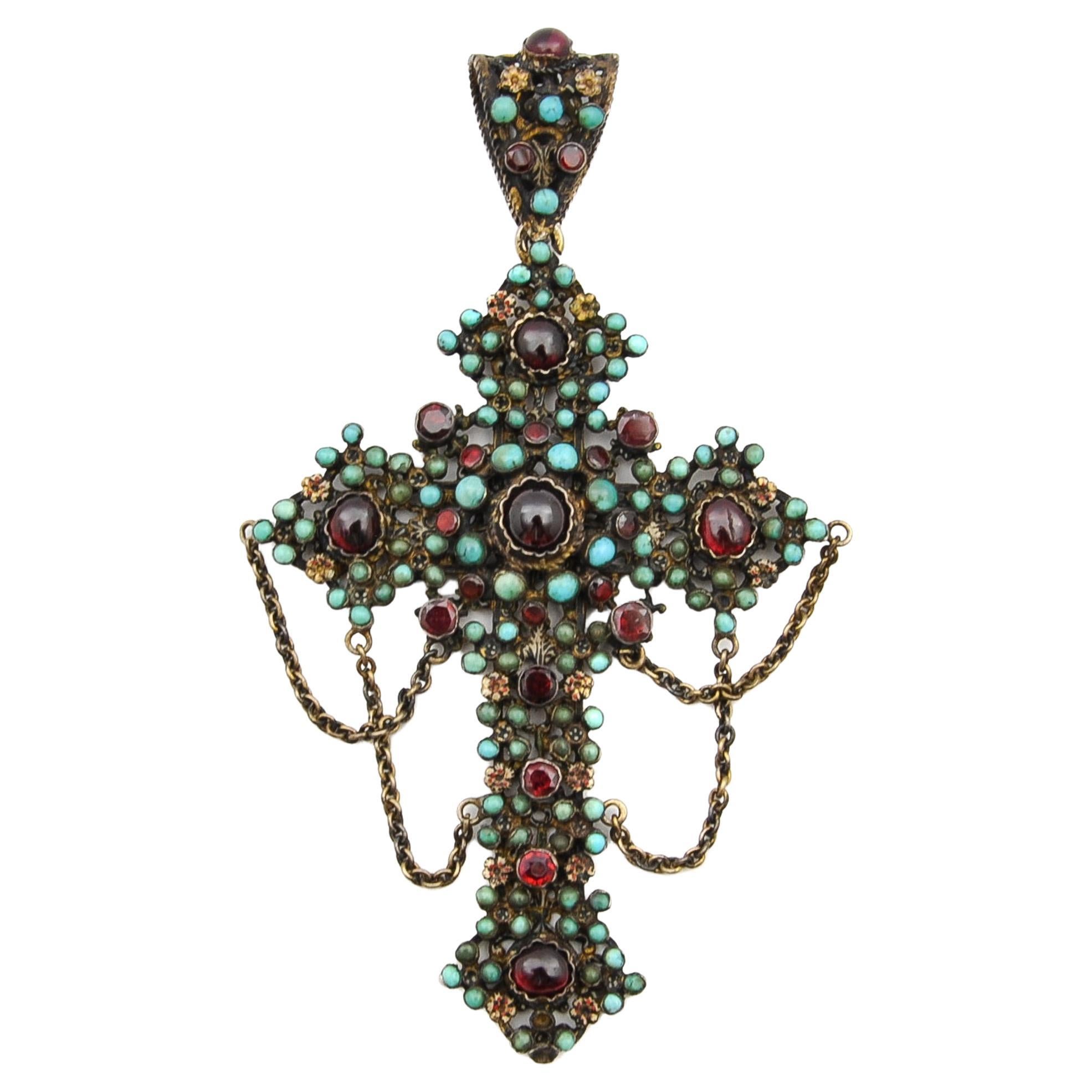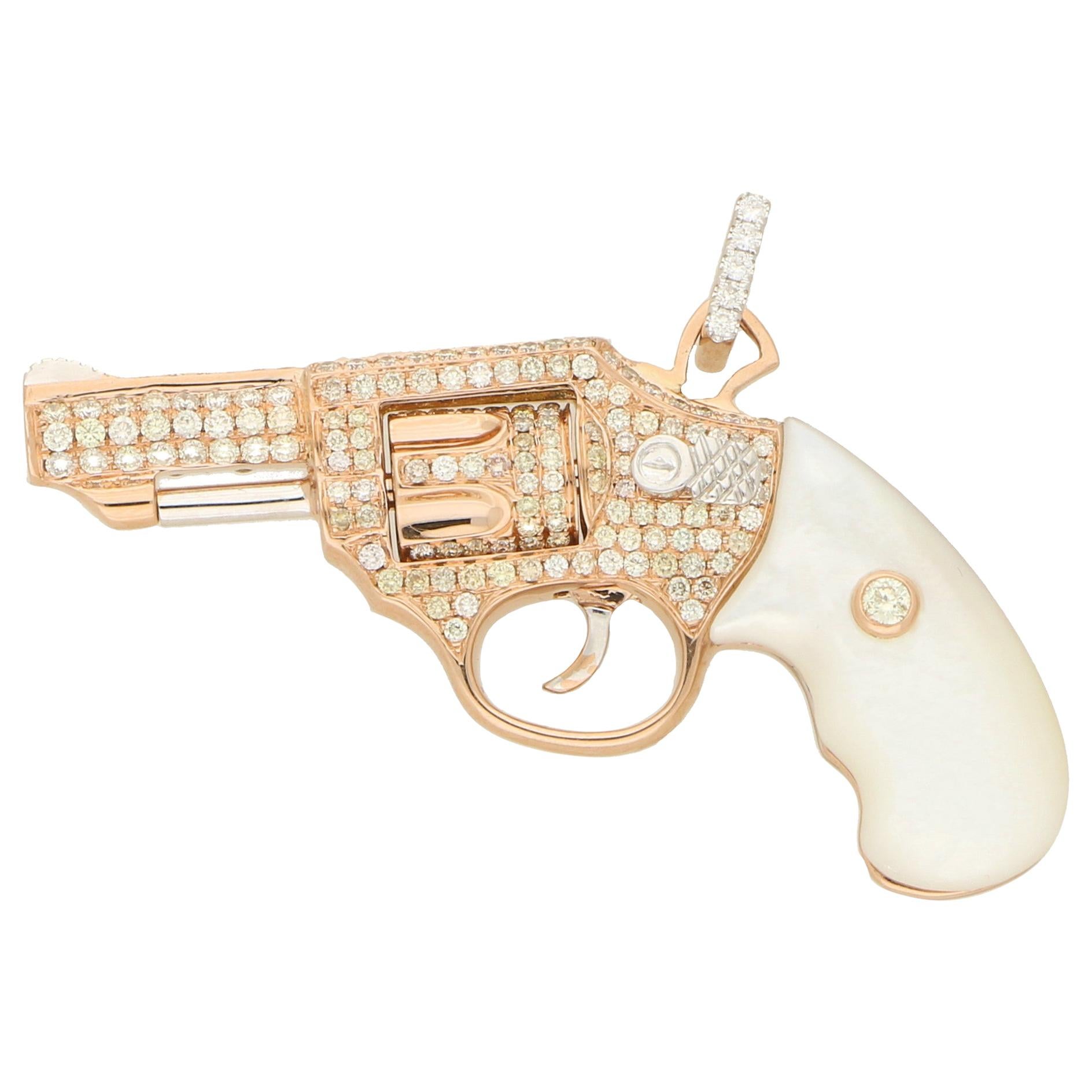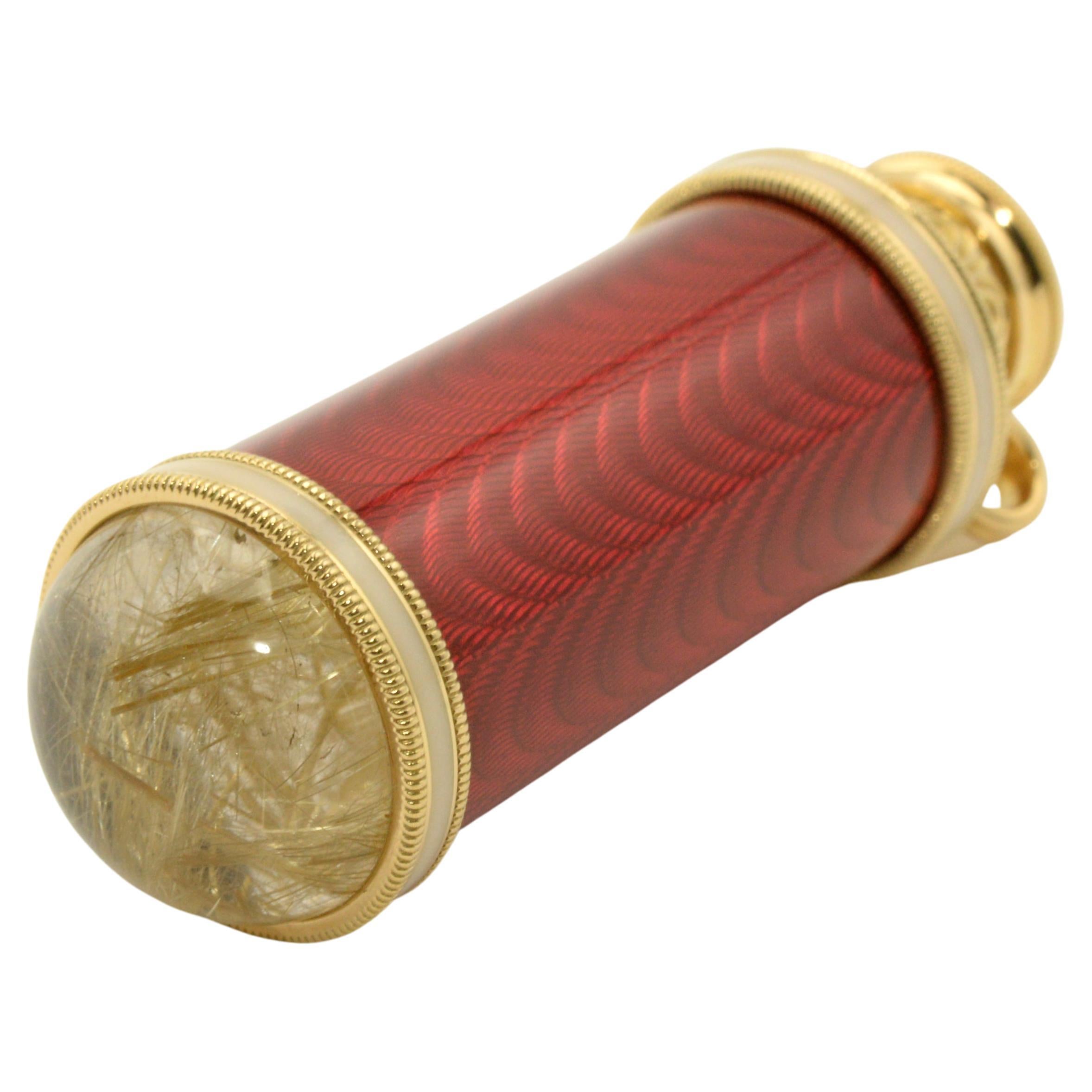Items Similar to Renaissance Reliquary Pendant with Pearl and Enameling
Video Loading
Want more images or videos?
Request additional images or videos from the seller
1 of 7
Renaissance Reliquary Pendant with Pearl and Enameling
About the Item
RELIQUARY PENDANT WITH PEARL
Spain or Spanish Netherlands, c. 1620
Gold, rock crystal, enamel, pearl, bone relics
Weight 12.9 grams; dimensions 40 × 17 mm
Gold three-sided pendant in rounded form with stylized acanthus scrolls and foliage in gold against black enamel. Each side has an oval opening with a convex crystal cover in an opaque blue enamel and gold frame, under which lies a bone relic (one is missing). On top and bottom is a foliate ornament with opaque white enamel and a peapod ornament with alternating opaque turquoise and dark blue enamel, imitating and lapis lazuli stones. Attached to these is the enameled pendant loop and suspended pearl pendant.
Gorgeously executed in gold with patterning in black enamel, this object likely completed a series of pendants, hanging at the bottom, itself terminating in a lovely pendant pearl. The understated richness of this object must have brought gladness to the heart of its owner: not only were its patterns lovely, but its manufacture spoke of exotic sources of colonial wealth—gold, turquoises, lapis, seed pearls, and large pearls. Never mind that the “turquoise,” “lapis,” and “seed pearls” are simulated with enamel; the final effect could not be more elegant.
The design highlighted in black enamel, with its curling and fanciful vines and buds, resembles the engravings of Michel le Blon (1587–1656). Born in Frankfurt, le Blon was active in Sweden, London, and Antwerp and published designs in Amsterdam; illustrated here are engraved patterns for a sword sheath. Nothing could be more appropriate for patrons of the courts than such a cosmopolitan artist working in an international language of design.
Also surely pleasing for the patron was the nature of this object as a sort of devotional “fidget-spinner.” The three-sided presentation does not favor any particular view, but encourages its user to rotate it and study it from different angles. This is not an object that rests easily in any single position. Neither is it easy to view its relics—one might be missing—or perhaps one should understand vision to be justifiably thwarted. The viewing of relics is achieved only, in the main, with great difficulty. Given that these are not identified by inscription or a visible vellum authentic, the knowledge of whose relics they are is something of a secret.
This sort of devotion is focused at the same time it is distracted into movement. This is indeed a good example of the theology of relics: what one catches sight of inside these precisely framed rock crystal “windows” is only a tiny splinter that represents the breadth and depth of the sacred, a window into the turning of the heavens.
- Metal:
- Stone:
- Stone Cut:
- Weight:12.9 g
- Dimensions:Height: 1.58 in (40 mm)Width: 0.67 in (17 mm)
- Style:
- Place of Origin:
- Period:1620-1629
- Date of Manufacture:1620
- Condition:Wear consistent with age and use.
- Seller Location:Chicago, IL
- Reference Number:
About the Seller
5.0
Vetted Seller
These experienced sellers undergo a comprehensive evaluation by our team of in-house experts.
Established in 1991
1stDibs seller since 2021
Typical response time: 13 hours
- ShippingRetrieving quote...Ships From: Chicago, IL
- Return PolicyA return for this item may be initiated within 3 days of delivery.
More From This SellerView All
- Late Renaissance Octagonal Gilded Brass Reliquary Pendant with Velvet InteriorLocated in Chicago, ILOCTAGONAL RELIQUARY PENDANT Probably Italy, c. 1600 Fire-gilded brass, glass, velvet, ink on paper Weight 63.2 grams; dimensions 82 × 47 × 21 mm (with loop) Physical description: Double-sided pendant in octagonal form made of fire-gilded brass. Both sides of the pendant with deep profiled frames with glass. The slightly indented side panels comprise openwork friezes with symmetrical scrollwork. On the front is dark red velvet, onto which tiny bone relics of saints (now missing) would have been attached. Labels on a lace-like paper silhouette remain, with names written in ink, mostly faded; only “S. Agnes” is legible. The back is hinged and when opened reveals a velvet-lined interior and paper insert with floral decorations on a turquoise ground, on which fragments of bones are attached. Baluster shaped base for shield-like pendant loop and ring. This reliquary pendant is difficult to situate historically because it is a composite object. It represents traditional handwork in the form of a paper cutout, combined with a jeweler’s beautiful fire-gilt brass case. The work of paper cutting, painting, and ornamentation, sometime combined with needlework, is comparable to work still being done in the nineteenth century by nuns and pious ladies. It is prayerful work, a devotional exercise in itself, and shows reverence to the tiny relic fragments that it would have framed and honored. Early versions of this sort of handiwork might be found in the meticulous displays sometimes called “Paradise Gardens.” These were made, beginning in the sixteenth century, by the nuns at Mechelen, in northern Belgium, in multimedia handwork displays of sewing and gluing, combining relics with paper, cloth, glass, metal wire, and found materials. These textured and pious displays were then combined with paintings and cases by professional artists and artisans, as in the example in Cassel. Unfortunately, because of water damage, only one of the labels of the original relic displayed in this reliquary is legible, inscribed “S. Agnes” at the center top; the other names are faded. Presumably the deep velvet-lined box would have also held an assortment of relics other than the ones that were visible through the glass, and perhaps there would have been another display in the glass on the other side of the pendant. There is a second paper insert, this one decorated with a turquoise ground and silhouette flowers to which bone fragments seem to be still attached. The octagonal case, in contrast to the paper cutout, is not at all “home-made.” It has an openwork frieze in scrollwork patterns familiar from enamel work and other metalwork done for European courts and nobility. It is not unlike cases for expensive watches...Category
Antique Early 1600s Italian Pendant Necklaces
MaterialsBrass
- Enameled Heart-Shaped Pendant with Cherub & Seed Pearls by Carlo Giuliano c.1880By Carlo GiulianoLocated in Chicago, ILCarlo Giuliano HEART-SHAPED PENDANT WITH CHERUB England (London), c. 1880 Gold, enamel, seed pearls Weight 8.6 gr.; Height 33.3 (42.1 with loop) mm; Width 30.8 mm; Of all the Reviv...Category
Antique 1880s English Revival Pendant Necklaces
MaterialsPearl, Gold, Enamel
- Antique Reliquary Book Pendant LocketLocated in Chicago, ILRELIQUARY PENDANT IN BOOK FORM Probably southern Germany, 1630–40 Gilded silver, verre églomisé Weight 13.2 grams; dimensions 42 × 25 × 12 mm; opens to 40 mm Gilded silver pendant in book form with hinged, lid, corded wire surround, and engraved spine. The front cover of the book is set with a plaque depicting Moses receiving the Law in verre églomisé, and the back cover shows the Sacrifice of Abraham. The scenes are in gold against a red background. When opened, the book reveals two portraits, probably of a husband and wife, wearing seventeenth-century dress. The costumes suggest a date c. 1630-40; the wife holds a daisy. Trefoil-shaped pendant loop on top and bottom, and book clasp. As in the scenario described for the assemblage of these pendant miniature books (see no. 34), this book may have satisfied the desires of a particular patron, perhaps even one of the Jewish faith. The images that have been chosen for the four verre églomisé inserts are somewhat unusual within the group of comparable objects; on the front is Moses, on the back is the Sacrifice of Isaac. On the inside, instead of an iconic or doctrinal image, one sees portraits of the patron and his wife, in their finest dress, contents reminiscent of a modern locket...Category
Antique Mid-17th Century Pendant Necklaces
MaterialsGilt Metal
- Antique Gold Pendant with Diamonds and PearlsLocated in Chicago, ILPendant with Virgin Mary as Queen of Heaven Western Europe, Southern Germany (?), Italy (?), c. 1550-1560 Gold, enamel, diamonds, and pearls Weight 13.2 gr; Length 36.9 x 31.2 mm (incl. pearls) This sumptuous image exudes regal power. It portrays the Virgin Mary as Queen of Heaven wearing a dress and crown studded with seven large diamonds and set against a translucent, rich blue celestial background. Far removed from the tender, humble Virgin seen in German and Netherlandish artworks of the period, she is a majestic ruler, mouth sternly set, head tilted upward, and face in full profile. The oval pendant cast in high gold relief with a central medallion, the single figure filling the space, echoes jewelry portraits of the aristocracy during the Renaissance, which similarly offset the ruler’s image against a blue field composed of enamel or lapis lazuli, symbolic of divine power Only the rays of the shining gold halo that emerge behind the Virgin’s head and her long flowing hair (instead of neatly coiffed) distinguish her from female ruler portraits of the period. Three studded pearls, forming an axis, also recall pendants of European rulers. Wealth, royal status, and divine power come together in this opulent pendant. Portraits of the period show similar small oval pendants worn by women in the square of the garment or by men nestled inside multiple chains below the base of the neck. PROVENANCE European Private Collection LITERATURE Compare images from ancient Rome, for example a sardonyx cameo with female head (Kugel 2000, no. 18; Milan, c. 1550), and a pendant with gold, pearls, and enamel in the Staatliche Museum Kassel (Schmidberger/Richter 2001, no. 43; France, c. 1555-1560). For ruler pendants with blue backgrounds see a pendant of King Frances I...Category
Antique 16th Century Pendant Necklaces
MaterialsDiamond, Pearl, Gold
- Renaissance Gemstone Ring with Garnet and EnamelLocated in Chicago, ILRenaissance Gemstone Ring Northern Italy, 16th century Gold, garnet and enamel Circumference 60 mm.; weight 4 gr.; US size 9; UK size R ½ The ...Category
Antique 16th Century Italian Renaissance Engagement Rings
MaterialsGold
- Fifteenth Century Reliquary Pendant with Christ on the CrossLocated in Chicago, ILReliquary Pendant with Christ on the Cross Germany, c. 1480–1500 Gilded silver Weight 35 grams; dimensions 69 × 46 × 8 mm A mixture of forms gives t...Category
Antique 15th Century and Earlier German Figurines and Sculptures
MaterialsSilver, Gilt Metal
You May Also Like
- Renaissance Cameo PendantLocated in New Orleans, LAThe cameo at the center of this exceptional pendant is a stunning example of the art of gem engraving during the Renaissance. It likely dates to the early 17th century and features a sacrificial scene inspired by the Greco-Roman era. The central flaming altar is flanked by two figures preparing to sacrifice a ram, while a figure in a lion skin blowing horns stands in the left corner. The carver brilliantly uses the natural layers of the stone to achieve the illusion of shadow and musculature on the figures. A second, smaller cameo is set at the top of the pendant, while a myriad of multi-colored gems, pearls and enamel adorns the 18K gold setting. A large Baroque pearl suspended from an enamel dragon finishes the design, which embodies the opulence and theatricality of jewels from the Renaissance age. Cameos and intaglios were highly popular amongst wealthy connoisseurs in Renaissance Italy, and owning the finest pieces was the privilege of princes. Although they were often elaborately mounted for display alone, cameos were also frequently worn as pendants, surrounded by enameled and stone-set gold frames. Such pieces were particularly prized by the Medici and Lorraine families, many of which can now be seen at the National Archeological Museum in Florence. Very few Renaissance cameos...Category
Antique 17th Century Italian Renaissance Pendant Necklaces
MaterialsMulti-gemstone, Pearl, 18k Gold, Enamel
- Antique Austro-Hungarian Turquoise Garnet Enamel Cross PendantLocated in Rotterdam, NLThis large 1860's Austro-Hungarian antique cross pendant is set with many turquoise and garnet gemstones. The four cabochon cut garnet stones on front of the cross are all set in rai...Category
Antique Late 19th Century Hungarian Renaissance Revival Pendant Necklaces
MaterialsGarnet, Turquoise, Silver, Enamel, Gilt Metal
- Diamond and Mother of Pearl Jeweled Gun Pendant in Rose GoldLocated in London, GBA diamond and mother of pearl gun pendant in 18-karat rose and white gold. Whether you are a fan of James Bond or usually root for the Bond Villain, it is hard to ignore this exquisi...Category
21st Century and Contemporary Unknown Contemporary Pendant Necklaces
MaterialsDiamond, Pearl, 18k Gold, Rose Gold
- Award Winning Design Red Guilloché Enamel Kaleidoscope Pendant in 18ky GoldLocated in Boulder, COThis exceptionally crafted and beautiful piece of art is unlike anything you will find in the world. The artists write up on the technical aspects of the piece are below. Enamel engraving was created on a very rare ornamental lathe from 1875. Old world artisans like Faberge used these machines for their works. This is a truly impressive creation and wow piece of jewelry and objet de"art! This Red Guilloché enamel Kaleidoscope Pendant...Category
Early 2000s American Art Deco Pendant Necklaces
MaterialsQuartz, Gold, 18k Gold, Enamel
- Deakin & Francis 18 Karat Yellow Gold Oval Turquoise Enamel LocketBy Deakin & FrancisLocated in Birmingham, West MidlandsDEAKIN & FRANCIS, Piccadilly Arcade, London This stunning vintage locket is the perfect gift for all. Made to keep personal things close at all times t...Category
Early 2000s British Contemporary Pendant Necklaces
MaterialsEnamel, Gold, 18k Gold, Yellow Gold
- Cartier Platinum Yellow Gold Diamond Black Enamel Pendant Watch NecklaceBy CartierLocated in New York, NYThis unique and wonderful Cartier Paris Pendant-Watch necklace was manufactured ca. 1920 with the dial movement and case signed Cartier. The original guilloche dial has enamel roman numerals and fine enamel minute bars on the perimeter. The watch crystal is held within a fine gold ring...Category
Early 20th Century French Art Deco More Objets d'Art and Vertu
MaterialsDiamond, Pearl, Gold, 18k Gold, Yellow Gold, Platinum, Enamel
Recently Viewed
View AllMore Ways To Browse
Engraved Bone
Dark Blue Enamel Jewelry
Seed Turquoise
Blue Enamel Pendant Pearls
Black Pearl Antique Necklace
Antique Black Pearl Necklace
Antique White Window Frame
Pearl Vine
Antique Seed Beads
Turquoise Seed Jewelry
Tiny Pearl Gold Necklace
Turquoise And Lapis Necklace
Antique Oval Window
Oval Turquoise Pendant
The Spinner
Tiny Gold Bead Necklace
Antique Crystal Ornaments
Turquoise Seed Pearls
